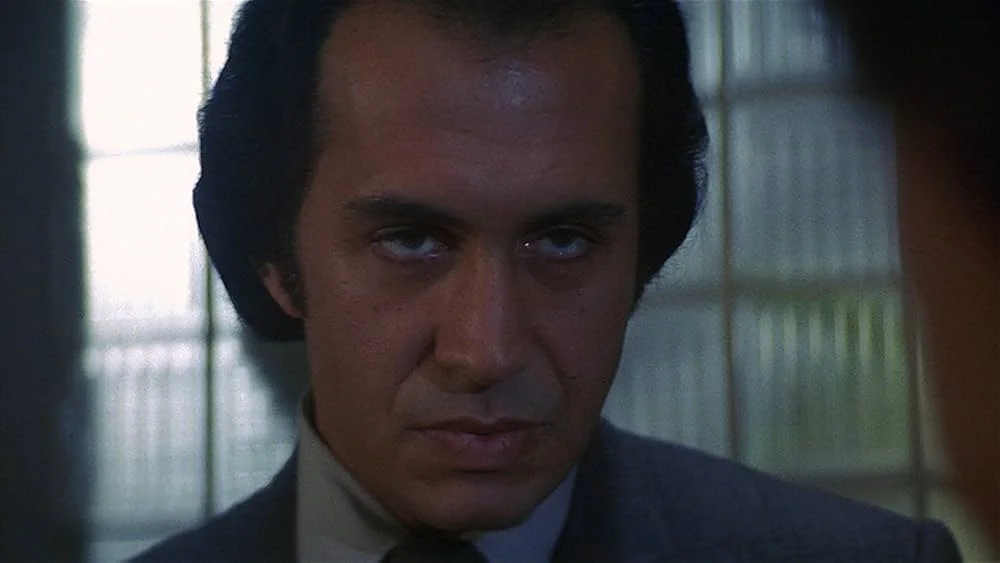Weird Wednesdays: Runaway
This screening was part of the Alamo Drafthouse’s Weird Wednesday series. For upcoming shows, click here.
It may seem like a different universe now, but there was a period starting in the early 1980s where the band Kiss took off all of their makeup, sharing their natural faces with the burgeoning MTV generation. While they had their major hits and misses as musicians during the unmasked era, long-tongued bassist Gene Simmons decided to take his natural face in a different direction: the big screen. While making his acting debut alongside the band in Hanna-Barbera’s ill-fated 1978 TV movie Kiss Meets the Phantom of the Park, from 1984 to 1989 he went on a solo adventure in acting, both big-screen and small. The first of these was a little sci-fi thriller called Runaway.
Runaway was directed by Michael Crichton, already a major player in Science Fiction as a novelist, with hits like The Andromeda Strain, as a director, helming the original Westworld film, and even as a game designer, writing a text adventure called Amazon, all groundbreaking works for their time. To contemporary audiences, he is no doubt most remembered as the author behind Jurassic Park and the creator of TV megahit ER, but in 1984 he was working on a vision of the future that proved to be a bit more realistic than it may have seemed at the time.
In an age when most people didn’t even know what the internet was, Crichton set Runaway in an unspecified near future where we depend on artificially intelligent robots for our everyday household and work-related tasks. Cars can be automated, serving your kids hot dogs can be automated, and even terrorism can be automated. When an everyday robot goes off protocol, it’s classified as a “runaway” and assigned to a certain division of the police that specializes in such cases. This is how the audience is introduced to Sgt. Jack Ramsey (Tom Selleck,) a veteran officer and single father who took a role on this task force after his vertigo allowed a family to get killed. On the day that he finds himself training a new partner, Karen Thompson (Cynthia Rhodes,) a robot goes haywire and commits the first homicide of robotkind. Normally Ramsey’s job amounts to tech support with a badge, but after disabling the wayward bot, things only get worse.
The murder is directly tied to, naturally, technology that can turn everyday household items into weapons of war, in this case circuitry that can allow a robot to be reprogrammed to attack humans (Asimov would be aghast). Behind these circuits are templates that can be used to make more, and Dr. Charles Luther (Gene Simmons) wants them, and he’ll hurt, kill, and otherwise technologically inconvenience anyone who gets in his way utilizing an arsenal that includes a miniature heat-seeking smart bullet that can follow a specific target anywhere, as well as some nasty little spider droids that will either inject their target with acid, or completely explode when disturbed.
While there may be a fair bit of ‘80s cheese and perhaps the most convoluted setup for a car chase in film history, one that really exists to pull off an impressive jump from one car to another under the ruse of keeping Luther’s girlfriend (Kirstie Alley) safe, Runaway works like a charm when it gets serious. Looking past the melodrama with Ramsey’s son and the forced (I suppose expected for the era) will they/won’t they romance between the cop duo, when the movie leans into full thriller mode it works, particularly during a tense showdown between Ramsey and Luther at a high-rise that is still very much in the early stages of construction. Those who have a fear of heights will feel for Ramsey as the camera sits through a long elevator ride, followed by a number of close calls and daring stunts in a pre-CGI world. Do the good guys win? Does technoterrorism survive? If you haven’t seen this movie in any of its 41 years, you should find out for yourself, and beyond Crichton’s shockingly prescient ideas about how mankind would come to rely on technology for everyday tasks (a vision that has played out far more sleekly in a post-Steve Jobs world,) I’ll give you the best reason why.
For all his flaws, controversies, and legendarily out-of-pocket quotes, Gene Simmons is one damn compelling actor. For his big-screen debut, he’s absolutely incredible, working from a looming presence of seething menace to a complete lunatic hellbent on making our heroes suffer. The whole cast is solid, with Selleck really grounding situations that could be utterly absurd in the wrong hands, but Gene Simmons is the main attraction by the end of the journey. I think of all the musicians who tried their hand at acting part-time, Simmons could have been one of the greats, alongside names like David Bowie and Meat Loaf. He knew how to cut an imposing figure and he didn’t hold back, especially in a trifecta of films that began with this one where he played three very different terrorists.
In 1986’s Never Too Young to Die (which Hyperreal was gracious enough to allow me to program and present this past August as part of the Summer Camp series,) again Simmons is the main attraction, giving it all the Frank N. Furter gusto he can muster as Velvet Von Ragnar, an intersex, psychotic terrorist with a nightclub act, a flair for the glamorous, and a plan to poison the local water supply. The only person who can stop him? Lance Stargrove (John Stamos,) a petulant teenage gymnast whose spy dad (single-serving Bond George Lazenby) dies by Velvet’s hand and leaves him the task of accidentally stopping a terrorist plot with the help of a mysterious woman (Vanity) and a roommate (Peter Kwong) who just happens to make all sorts of gadgets like one-man Q Branch. The songs are catchy, the hero is inept, and the delusional producer thought he was really making the next James Bond franchise, but what he got was a box-office flop that just might be my favorite (note: not BEST) movie ever made, and again, Simmons is the main attraction here, selling every moment of Velvet’s campy screentime like he was going for an Oscar. Every moment of this movie deserves to be seen by anyone who loves the theater of the absurd, but Simmons wasn’t done just yet.
In 1986, he appeared in Wanted: Dead or Alive, a film based on a Steve McQueen TV series from the 1950s. Rutger Hauer stars as Nick Randall, descendant of the TV show’s hero Josh Randall, a badass bounty hunter in a black trenchcoat who rocks a mean shotgun and a meaner harmonica. On paper, it’s a by the numbers tale, as Randall hunts down Simmons as Malak Al-Rahim, a Middle-Eastern terrorist with a penchant for bombs and brutality. In the tradition of the ‘80s, it’s none too culturally sensitive, nor is the story particularly original, but Hauer and Simmons make great adversaries, their showdown is fantastically staged, and the entire 104 minutes is worth one of the all-time great movie-ending one-liners. A constant cable favorite in the ‘90s, the Middle-Eastern terrorism plot line has aged like milk, but once again, Simmons shows up ready to give it his all, and he walks away the standout performance against a heavy hitter like Hauer.
Beyond this, Simmons had a nice guy turn as a radio DJ in 1986’s Trick or Treat, worked alongside a young George Clooney in 1989’s Red Surf, and TV appearances in Miami Vice and The Hitchhiker, before he went back to spitting blood, playing bass, wagging his tongue, and saying bombastic things for attention. Save for a few cameos (Extract, The New Guy,) most of his other film appearances have been Kiss-related, including the supremely underrated 1999 raunchy teen comedy Detroit Rock City, a far better movie than the same year’s more popular release American Pie, as well as time spent as a reality show star, author, and potentially the most controversial figure in rock and roll. To me he’s like that uncle that just shows up to say provocative things every time the family gets together, but when he shuts up you can’t deny that he’s kind of fascinating. I just wish he’d done more than ride the Kiss train until the wheels fell off. His brand of tall, dark, and sinister would have made for a damn good Randall Flagg.
His brief acting career would not have been possible without Runaway though, and getting to see it presented for Weird Wednesday in a beautifully pristine 35mm print was a joy for longtime fans of the film like myself as well the newcomers who seemed to have a blast with it. A fascinating view of the near-future from a brilliant mind, you owe it to yourself to see all of Crichton’s sadly small directorial filmography. While Spielberg’s adaptation of Jurassic Park may have defined his career for many, Runaway is a fine starting point for the rest of his prolific career as a master storyteller.
If you enjoyed this article, please consider becoming a patron of Hyperreal Film Journal for as low as $3 a month!



Jackie Stargrove is a writer, singer, movie host, and the smallest pillar of the Austin film community.